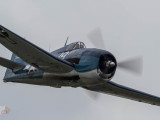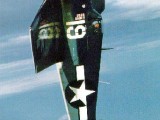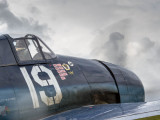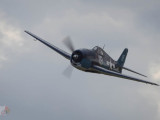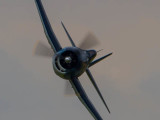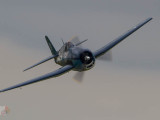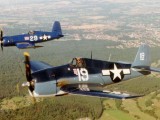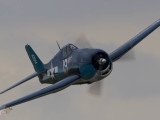Grumman Hellcat F6F G-BTCC (This aircraft is no longer part of the collection at Duxford)
The Grumman F6F Hellcat design was greatly influenced by feedback from squadrons flying her direct ancestor, the F4F Wildcat, in the Pacific Theatre as well as input from studying European Theatre air combat reports. The Hellcat was ordered by the US Navy in June 1941, and less than ayear later the prototype XF6F-1 flew. During prototype flight trials it was realised that a more powerful engine would give the Hellcat an edge in combat and so she was mated with a 2000hp Pratt & Whitney R2800-10 and subsequently re-designated the F6F-3. It was in this guise that she made her combat debut in August 1943.
The Hellcat must be considered one of the best carrier-borne aircraft of all time, with outstandingperformance at any altitude. The type made its presence known by accounting for 75% of all USNaval aerial victories securing air supremacy across the Pacific Theatre. The Hellcat also holds the distinction of destroying more enemy aircraft, over 5000, than any other Allied aircraft.
In additionto her US Naval service, the Hellcat also served with the US Marine Corps in the Pacific and with the British Fleet Air Arm in Europe where she was initially known as the Grumman Gannet Mk.I before reverting back to her American name in early 1943.
The Fighter Collection’s Hellcat is the only example flying outside of America and is presented in the colours of US Navy Ace Lt Alex Vraciu who flew this particular aircraft. Vraciu finished the war as the US Navy’s fourth highest ace with 19 aerial victories, 9 of which whilst flying this particular aircraft when assigned to Navy Squadron VF-6 aboard USS Intrepid (CV-11).
Our Hellcat was built in late 1943 and issued directly to VF-6 where she amounted 115.7 flying hours before being transferred to the newly-formed VF-18 which was undergoing pre-deployment workupsat Hilo in the Hawaiian Islands. A further 200 hours were clocked up with VF-18 being flown by anumber of pilots who went on to become Aces, before being transferred to the Naval Air Technical Training College (NATTC) in Chicago during August 1944. It was whilst she was at the NATTC that she was re-united with Alex Vraciu during a War Bond fund raising tour of the Mid-West. Following amajor rally in Chicago, she was left on show at a naval base in the city until being struck off charge when the NATTC closed. The Chicago vocational training school duly opened in its place and ourHellcat continued to serve as a training aid for the next 20 years.
The Hellcat was then acquired by collector Earl Rienhart and displayed as part of his Victory AirMuseum outside at an airstrip in Mundelein, Illinois. In 1979 she passed to Ed Maloney and wasmoved to the Planes of Fame collection in California, where she was stored until around 1983 when she moved into the ownership of Tom Friedkin to assist in the rebuild of his own Hellcat which suffered serious damage as a result of a forced landing following an engine failure in April 1979.
The restoration incorporated the port wing from the crashed example and an unused, crated starboard wing along with the fuselage from our Hellcat, but used the identity of the Friedkin’s machine (F6F-5K Bu No 80141) for convenience. Before the rebuild could be completed she passed to the Yankee Air Corps at Chino, California.
In 1988 the incomplete Hellcat became part of The Fighter Collection when Fighter Rebuilders, also at Chino, were commissioned to continue the rebuild following which she was shipped to the UK where she arrived in August 1990.
The Fighter Collection contacted Alex Vraciu, who confirmed its war record, provided details of her colour scheme and even lent owner, Stephen Grey, his original flying gloves for his first flight in the recently completed Hellcat. Alex was even able to reacquaint himself with his old mount when he travelled to Duxford.
Since her arrival our Hellcat has been a popular performer appearing at many airshows across Europe demonstrating the type’s amazing performance which made such an impact across the Pacific Theatre during World War Two.
Specifications:
Manufacturer: GRUMMAN AIRCRAFT ENGINEERING CORPORATION
Type: GRUMMAN F6F-3
Maximum Take off Weight: 4990kg
Year Built: 1944
Engines: 1 x PRATT & WHITNEY R-2800-75
Propeller: HAMILTON STANDARD 23E50-
Gallery:


